Totally inspired by John Lautner’s villa Chemosphere , this modern version of a spaceship house is simply fantastic. The only difference is that John’s version was stationary and this one’s a trailer. The beauty of this house-on-wheels lies in the fact that its compact and yet boats of ample living quarters. You will find a bathroom, living room, bedroom, kitchen and an office in the 252° Living Area: Mobile Mini House. The entire setup of the trailer is based on the rooms fanning out to a 252° radius. The mobile walls and floor of each unit run on rails and can be slid open easily. Just like you open one of those Japanese fans , open up this trailer from under its protective shell and set up your mobile house. It’s as simple as that!
Oh, I forgot to mention that there is a sliding screen that encapsulates the house, to secure it and keep the elements at bay.
I have never done the trailer thing, but I know it must be fun to use one during those camping trips. If I were to get one, this would probably be it.
Designers: Stephanie Bellanger , Amaury Watine, François Gustin & David Dethoor
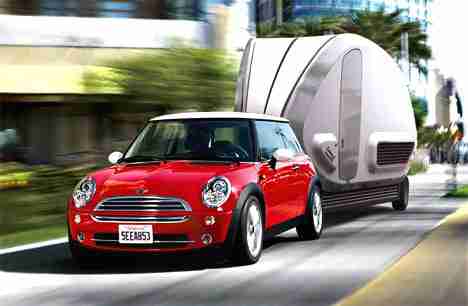
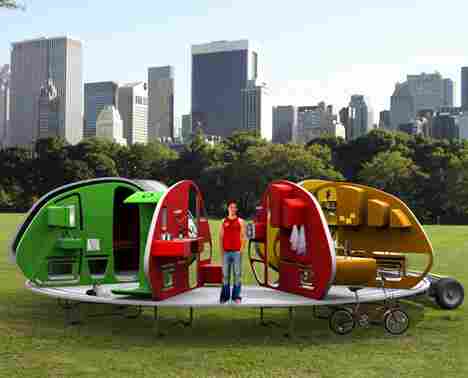
These floating island parks could be a part of our new normal!
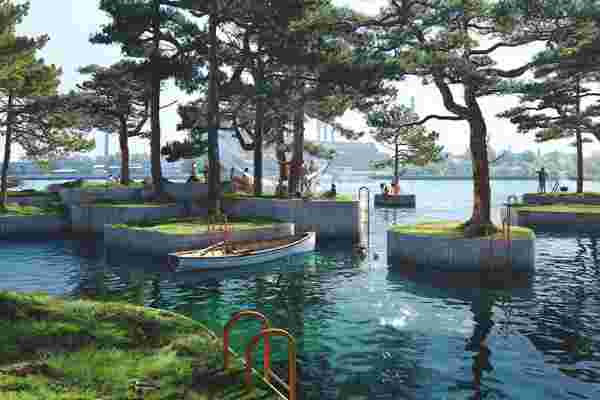
Have you heard that phrase “Whatever floats your boat”? If you are in Copenhagen, you might even hear “Whatever floats your park!” and that would be in reference to the world’s first “parkipelago” (a portmanteau of park and archipelago) which are a cluster of artificial floating island parks. Designed by a Danish design studio, Studio Fokstrot, and Australian architect Marshall Blecher, these islands were a part of urban development along the waterfront. They are officially called the Copenhagen Islands and each module is created with a flexible public program to keep the interest of the urban dwellers at its core.
Considering the accelerated rise of global sea levels, Copenhagen Islands are only the beginning of how urban design will adapt to the changing climate by optimizing the water bodies as sustainably as possible. “To renew the proud traditions of the Danish harbor life, by strengthening the social cohesion and awareness of the maritime life in and around the harbor,” says Studio Fokstrot as they explain the idea behind the floating parks. The islands are activity-friendly and enable visitors to enjoy boating, swimming, kayaking, picnics, performances, events, and more which could also boost tourism or simply make things better for citizens with travel being on the down-low this year. These programs can also be customized for seasons – summer is when the islands will be docked away from each other to create space for water activities while during winter the islands will huddle up closer for more engaging performances.
Thes first island to be tested on-site is called CPH-Ø1. The structure was built using thin strips of wood + steel and recycled boating material. The CPH-Ø1 was crafted with traditional boat-making techniques and it is approximately 215 square feet with a single linden tree – just like an island drawing a child makes! Each module will have different features but will be in harmony with one another. Architect Marshall Blecher mentions how careful landscaping and green patches will welcome new wildlife. Even the submerged portion of the islands are built in a way to be habitable for seaweed and small marine life which will encourage other animals to also get comfortable near these modules which aim to be symbiotic. The conceptual product wants to create a stronger focus on an improved harbor environment, the effects of climate changes, and the increased water levels, adapting to the new normal – some of the biggest problems the world is facing today.
Designer: Marshall Blecher and Studio Fokstrot
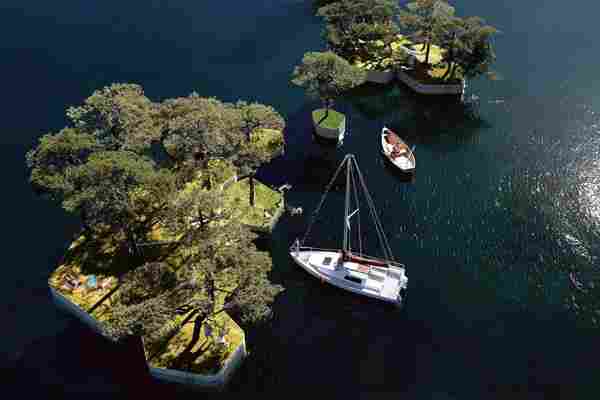
This sustainable home produces energy and stores excess solar power in two Tesla powerwalls!
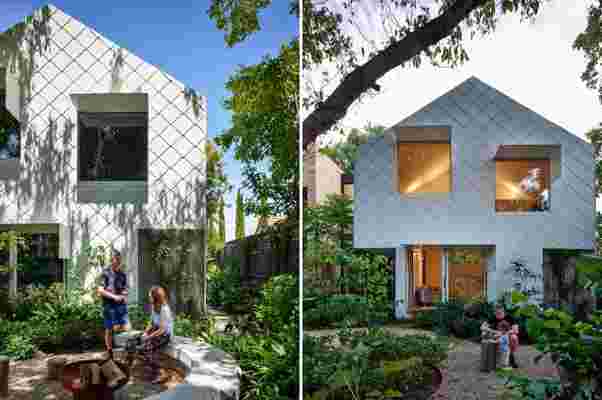
An essential pillar of AMA–Austin Maynard Architects is sustainability . Whether that be achieved through solar energy, Tesla batteries, external Venetian blinds, or all the above–building homes that leave small footprints on our environment is something of the utmost importance for the architects at Austin Maynard. Finishing work on their Garden House, the team of designers has built their most sustainable house yet, one that works as a power station, producing more sustainable energy than it uses.
On average, the Australian home uses 19 kWh of energy on any given day. Turning that statistic on its head, Garden House produces 100kwh of energy with help from a 26 kWh Tesla battery. Finding the future of home sustainability through this sharing of energy, Garden House is powered by solar energy and powers the block’s shared energy grid. Since many Australians utilize solar panels to power up their homes, Garden House is in good company on a narrow street filled with garden oases and blooming greenery. Careful not to disrupt the natural terrain in and around the house’s lot, AMA developed Garden House’s layout and connected pavilions based around the network of pre-existing garden spaces and trees. This set the stage and literally the foundation for the home’s commitment to producing more sustainable energy than it requires to run.
The architects behind Garden House ensured that the home utilized passive building techniques, filling out the roof with solar panels in addition to outfitting the inside with double studded wall insulation, underfloor insulation, formed from an insulated concrete slab. Even the building materials used were chosen for their sustainable edge, opting for recycled bricks to build the home’s linked pavilions behind its shingled white garage. Inside, the home does not require any gas for internal insulation of any kind–hot water, space heating and cooling, hydronic heating, and pool heating is all supplied through highly efficient heat pumps. In addition to being a fully automated smart home that runs on two Tesla power walls, the designers also did not disrupt the lot’s original landscape and natural greenery in building Garden House.
Tucked away in a lush paradise of a backyard, Garden House is a lot more than meets the eye. At first glance, Garden House’s garage showcases a humble home with a pentagon frame wrapped in optic white shingles. Beyond the garage, linked brick pavilions connect family rooms and bedrooms and appear as separate buildings entirely, joined only by mirrored glass corridors that reflect the surrounding leafy gardens. Each pavilion was designed to break up the bulk of the home into four smaller scale zones. Inside each section of the home, concealed doors grant access to the whole home as well as the garden. Open balconies and lofty kitchen doors open up to the gardens, filling the home and its garden with a paradisal air.
Designer: Austin Maynard Architects
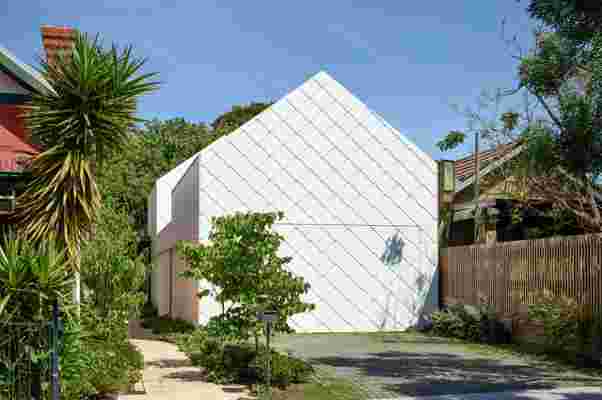
Using the home’s side entryway, the humble garage transforms into a lush backyard garden joined by concealed brick pavilions.
From the street, Garden House appears as a simple, pentagon-shaped home wrapped in optic white shingles.
Beyond the garage, Garden House blossoms into the family home that it is, accommodating five family members.
The home’s linked brick pavilions house bedrooms and family rooms that are connected by mirrored glass corridors.
The inside of the home features brick interiors for a rustic look in an otherwise extremely modern home.
Two Tesla power walls store the energy acquired from the roof’s solar panels.
Lofty doors and huge windows bring the family even closer to their backyard oasis.
Natural sunlight fills the halls and bedrooms throughout Garden House.
Ash black metal accents brighten natural wood cabinetry work.
Exterior Venetian blinds keep bedrooms from overheating due to the overflow of natural sunlight.








